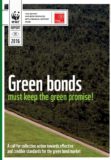New research commissioned by WWF and published today, shows that the proliferation of standards, frameworks and guidelines, as well as the diversity of market practices in terms of definitions and requirements for green bonds create complexity and confusion among issuers and investors which could hamper the confidence needed for the green bond market to thrive.
Creating a large, liquid market in green bonds – including aggregating small projects – offers a unique opportunity to boost the volume of capital available, as well as reducing the cost of debt for projects that drive the transition towards a sustainable economy.
As countries seek proactive solutions to the environmental challenges that are faced, green bonds and their associated standards can play an integral role for both the finance and conservation communities. However lack of standards has led to the risk of ‘greenwashing’, with not all green bonds fulfilling their green promise. Over the past couple of years several green bond issuances have been controversial among stakeholders[i]. As investors and issuers pay more attention to environmental, social and governance issues, green standards can further influence the wider market.
The research also finds that most frameworks and guidelines currently only look at the potential environmental impacts prior to issuing a bond, instead of assessing the actual environmental benefits of projects throughout the lifetime of the bond.
Focussing on promised environmental impacts rather than actual performance raises the risk of greenwashing if bonds are issued and perceived as green, while only achieving minor or in fact no actual environmental benefits.
Nicole Clucas, Sustainable Finance Specialist for WWF-UK commented:
“Green bonds are vital for the future of a sustainable economy, but not everything labelled ‘green’ fulfils its promise. There must be robust standards to ensure that people get what they expect. Vigorous, credible, fully-developed and widely-accepted industry standards for green bonds are urgently needed to ensure that the market thrives and the sustainable economy grows.
With the right level of commitment and collaboration among stakeholders, and guided by existing initiatives such as the Green Bond Principles and the Climate Bonds Initiative, it is possible to define a set of widely-accepted standards, building on some of the existing ones while taking into account scientific evidence.”
Pascal Canfin, CEO of WWF-France said:
“Only a bond for which the issuer can demonstrate measurable environmental benefits, certified by an independent party according to such widely-accepted, fully developed standards, should qualify as a green bond. Bonds which do not meet these standards could undermine the credibility of the entire green bond market.
We recognise that increased transparency represents an additional effort for the issuer but we believe that this is a ‘cost’ well worth incurring for the benefit of reduced risk. In a fully functioning market, such added value will be reflected in premiums and prices”.






